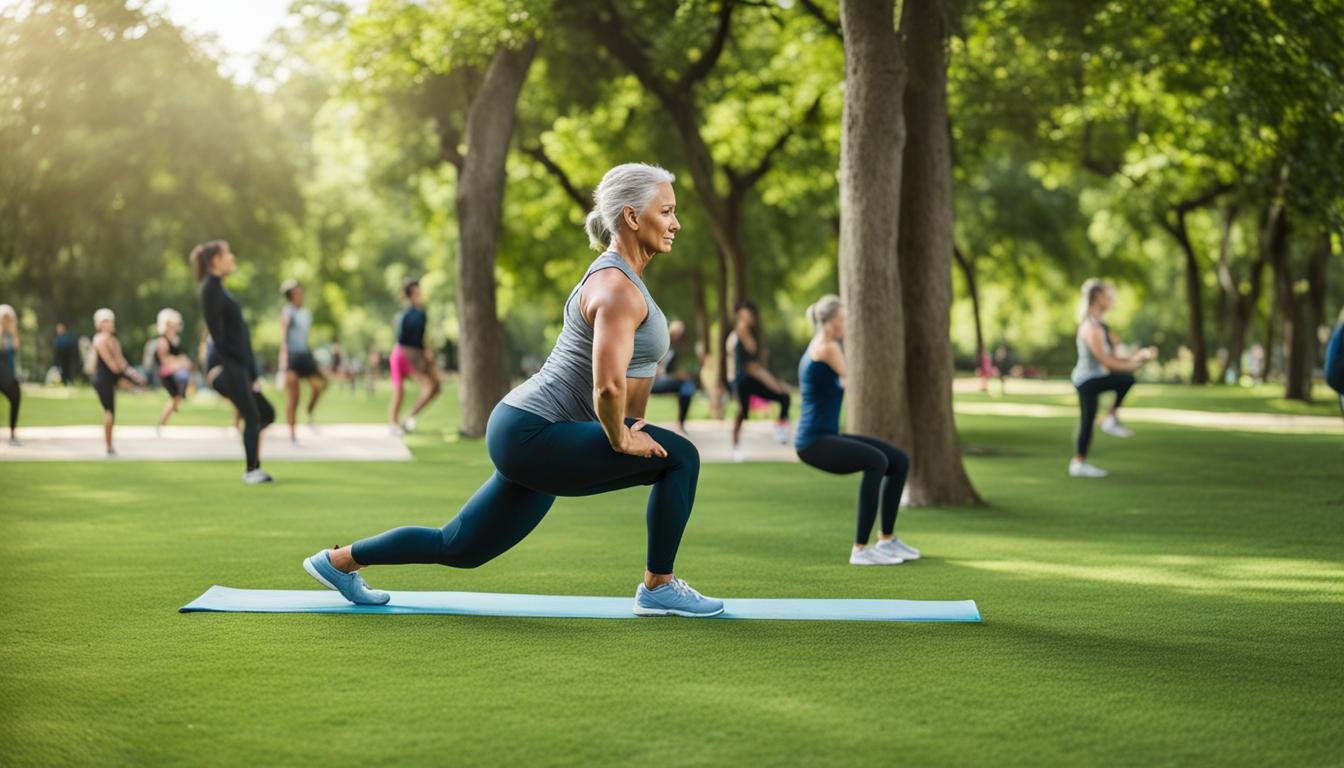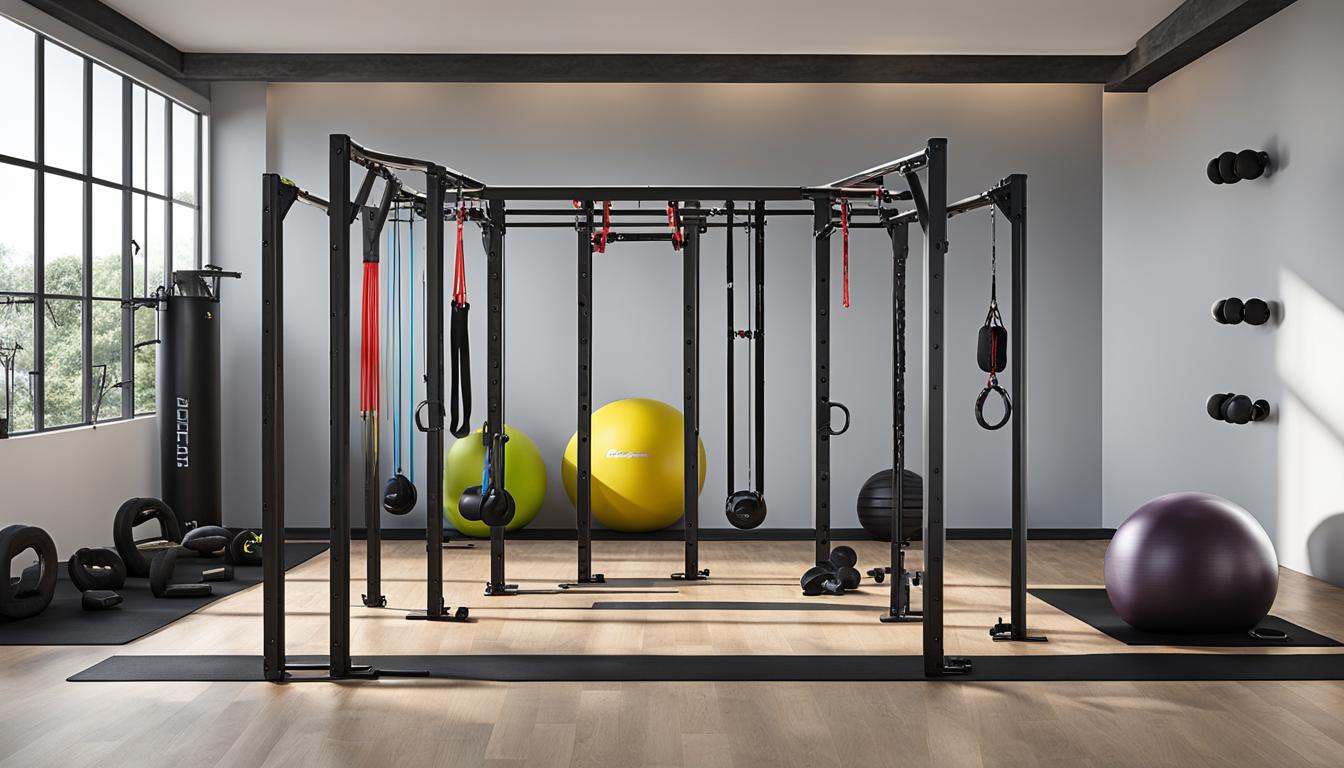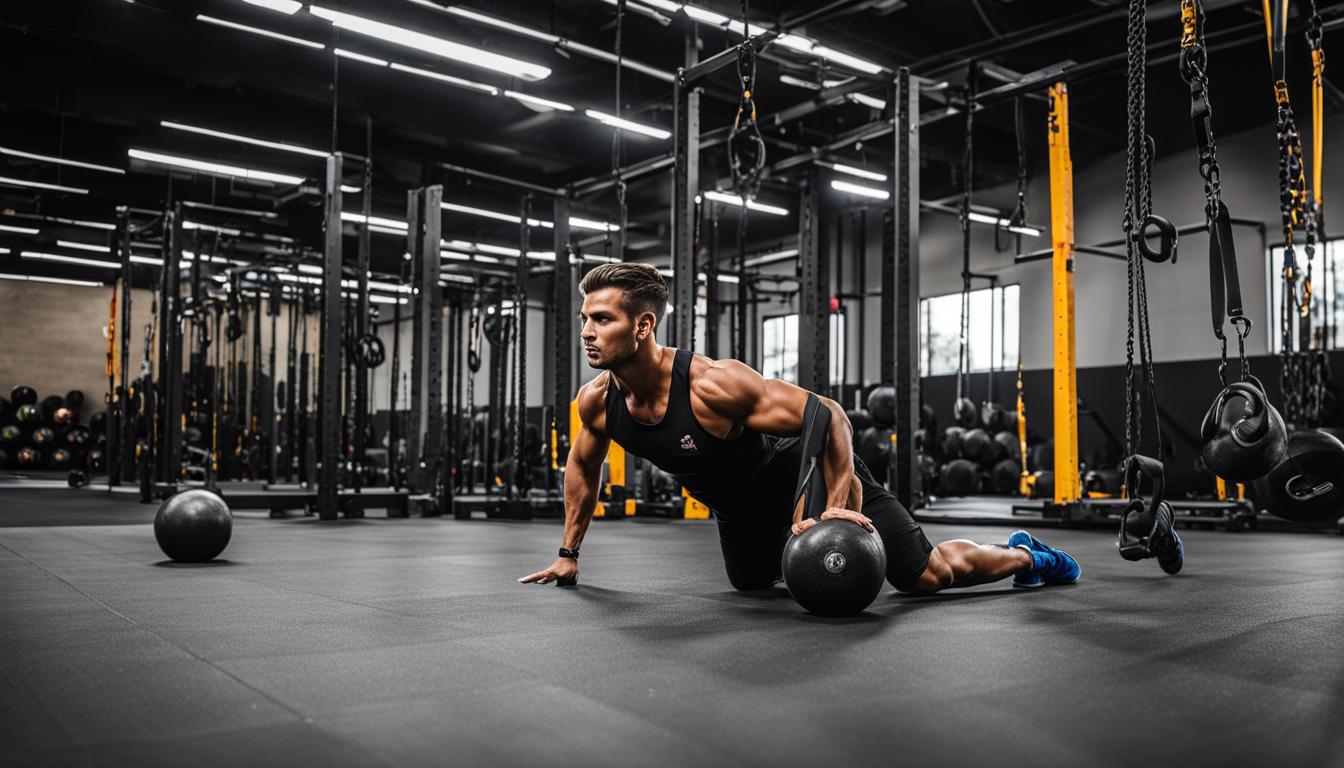If you’re looking for a workout program that can benefit people of all fitness levels, ages, and exercise experience, then functional fitness is for you. This type of training focuses on improving movement patterns, efficiency, coordination, mobility, and much more. In this article, we’ll explore the benefits of functional fitness and delve into some popular exercises you can incorporate into your routine.
Key Takeaways:
- Functional fitness programs can benefit individuals of all fitness levels, ages, and exercise experience.
- These programs improve movement patterns, efficiency, coordination, mobility, and more.
- Functional fitness exercises focus on movements rather than isolated muscle actions.
- Some of the benefits include improved core strength, stability, calorie burn, and reduced risk of injury.
- Stay tuned as we explore the origins of functional training and compare it to traditional strength training.
What is Functional Fitness?
Functional fitness refers to exercise that helps with everyday activities such as getting up off the floor, carrying heavy objects, and putting something up on a shelf. It focuses on movements rather than isolated muscle actions and aims to improve strength, power, and mobility that translates beyond the gym.
Functional training engages multiple muscle groups and expands range of motion. By incorporating exercises that mimic real-life movements, functional fitness improves balance, endurance, and flexibility, making daily activities easier and reducing the risk of injury.
One of the key principles of functional fitness is its focus on real-world movements. Unlike traditional strength training that targets specific muscle groups, functional fitness exercises are designed to replicate everyday activities, making them more applicable to daily life. This type of training helps individuals build the strength and mobility needed to carry out common tasks with ease.
“Functional fitness is all about making your body perform better in everyday activities, whether it’s lifting groceries, playing with your kids, or simply moving comfortably without pain,” says fitness expert and personal trainer, Sarah Reynolds.
The Importance of Functional Training
Functional training plays a crucial role in enhancing overall physical fitness. By engaging multiple muscle groups and emphasizing compound movements, it not only improves strength and power but also enhances mobility, balance, endurance, and flexibility.
Unlike traditional strength training that often isolates specific muscle groups, functional training targets the body as a whole, leading to more functional and practical results. Whether you want to improve your performance in a specific sport or simply move more effortlessly in daily life, functional fitness is the key.
Functional fitness exercises include movements like squats, lunges, push-ups, and balance exercises, among others. These exercises not only build strength but also enhance stability and coordination, making them invaluable for improving overall physical functionality.
Benefits of Functional Fitness
Incorporating functional fitness into your routine offers a wide range of benefits. By improving core strength, stability, and flexibility, functional training enhances overall movement patterns and makes everyday activities easier and more enjoyable.
Functional fitness workouts also promote a higher calorie burn compared to traditional strength training, thanks to the engagement of multiple muscle groups and the emphasis on compound movements. Additionally, the focus on proper movement patterns and the strengthening of the body as a whole helps reduce the risk of injuries or movement compensations.
Whether you’re an athlete looking to enhance your performance or a senior aiming to maintain mobility, functional fitness is a versatile and effective approach to achieving your fitness goals.
The Origins of Functional Training
Functional fitness has its origins in the rehabilitation of soldiers who returned from World War I with injuries that impaired their basic daily functions. These soldiers required physical therapy that focused on core strength and mobility, which are crucial for all kinds of movements. The rehabilitation programs aimed to restore their ability to perform everyday tasks and regain their independence.
This early application of functional fitness highlighted the importance of building a strong core and improving mobility for overall movement. The exercises and techniques used in the rehabilitation process were designed to mimic real-world movements, helping the soldiers regain functionality in their daily lives.
“The physical therapy provided to these soldiers focused on core strength and mobility, as these are fundamental for all movement.”
Fast forward to recent years, functional training has gained popularity and has expanded beyond rehabilitation programs. Today, it includes a wide range of equipment and exercises that simulate real-world movements and help individuals improve their overall physical functionality.
Functional fitness has come a long way since its humble beginnings, and its benefits are now enjoyed by people of all fitness levels and backgrounds. By incorporating functional training into their routines, individuals can improve their core strength, mobility, and overall movement patterns, leading to enhanced functional capacity in their daily lives.
Functional Training vs Traditional Strength Training
Functional training and traditional strength training are two different approaches to exercise. While both are effective in their own ways, they have distinct differences that set them apart. In this section, we will explore the disparities between these two training methods and understand why functional training has gained popularity in recent years.
Functional training places a strong emphasis on movements rather than isolated muscle actions. It focuses on training your body to perform everyday activities more efficiently and effectively. Instead of targeting specific muscle groups, functional training engages multiple muscle groups simultaneously to mimic real-life movements.
“Functional training expands your range of motion and improves your overall movement patterns, making it more applicable to everyday activities.”
In contrast, traditional strength training typically involves exercises that isolate specific muscle groups, such as bicep curls or leg extensions. These exercises are designed to build strength and increase muscle size in the targeted areas. While traditional strength training can help you develop muscle mass and strength, it may not transfer as well to real-world movements.
With functional training, compound movements that engage multiple joints and muscle groups are the focus. These exercises, such as squats, lunges, and deadlifts, not only improve strength but also enhance coordination, balance, and stability.
By incorporating compound movements, functional training expands your range of motion and improves your ability to perform everyday tasks. Whether you’re lifting a heavy object, climbing stairs, or reaching for something on a high shelf, functional training prepares your body for these movements.
Benefits of Functional Fitness Workouts
Functional fitness workouts offer numerous benefits for individuals of all ages and fitness levels. These workouts focus on improving core strength, stability, and balance, which are essential for overall movement and functionality.
One of the key advantages of functional fitness workouts is their ability to engage multiple muscle groups simultaneously. By incorporating compound movements and exercises that mimic real-life activities, these workouts promote calorie burn and improve overall fitness levels.
“Functional fitness workouts are designed to mimic real-world movements, making them highly effective in improving overall functional capacity.”
In addition to the physical benefits, functional fitness workouts also contribute to the reduction of injury risks. By promoting proper movement patterns and strengthening the body as a whole, these workouts help individuals maintain proper alignment and minimize the chances of injury during both everyday activities and other forms of exercise.
With their emphasis on functional movements, core strength, stability, and calorie burn, functional fitness workouts are a well-rounded approach to fitness that enhances overall movement and reduces injury risks.
Functional Fitness Exercises for Adults
Looking to incorporate functional fitness exercises into your workout routine? There are plenty of options that can help adults improve their strength, stability, and balance. These exercises target multiple muscle groups and make daily activities easier. Here are some functional fitness exercises you can try:
Squat:
The squat is a compound exercise that engages your lower body and core. It helps strengthen your quadriceps, hamstrings, glutes, and calves while improving your balance and stability.
Incline Chest Press:
The incline chest press targets your chest, shoulders, and triceps. By performing this exercise on an inclined bench, you can challenge your upper body muscles from a different angle.
Plank:
The plank is a fantastic exercise for building core strength. It engages your abdominal muscles, back, shoulders, and glutes, helping improve your posture and stability.
Wall Squat:
The wall squat is an effective exercise for strengthening your quadriceps, hamstrings, and glutes. It also helps improve your lower body endurance and stability.
Step-Downs:
Step-downs are great for targeting your quadriceps, hamstrings, and glutes. This exercise mimics movements like going downstairs or stepping off a curb, making it ideal for improving everyday mobility.
Row:
The row exercise strengthens your upper back, biceps, and rear deltoids. It can be performed using resistance bands, cable machines, or dumbbells.
Stationary Lunge:
Stationary lunges work your quadriceps, hamstrings, and glutes. This exercise also challenges your balance and stability while targeting one leg at a time.
Step-Up:
The step-up exercise focuses on your quadriceps, hamstrings, and glutes. It mimics movements like climbing stairs, helping improve overall lower body strength and stability.
Single-Leg Lift:
The single-leg lift targets your glutes and quadriceps while also improving your balance and stability. This exercise can be performed using bodyweight or with the assistance of resistance bands or dumbbells.
Side Plank:
The side plank is excellent for targeting your obliques, hips, and shoulders. It helps improve core stability and can be modified to suit different fitness levels.
Downward-Facing Dog:
The downward-facing dog is a yoga pose that stretches your hamstrings, calves, and shoulders while strengthening your upper body and core. It also helps improve flexibility and posture.
Single-Leg Deadlift:
The single-leg deadlift primarily works your hamstrings, glutes, and lower back. It challenges your balance and stability while targeting multiple muscle groups in your lower body.
Lunge with Bent-Over Row:
The lunge with bent-over row combines lower body strength with an upper body pulling movement. It targets your quadriceps, hamstrings, glutes, back, and arms, making it a great full-body exercise.

These functional fitness exercises offer a wide range of benefits for adults, helping improve strength, stability, and balance. Incorporating them into your workout routine can make daily activities easier and enhance your overall fitness level. Try adding a few of these exercises to your workouts and experience the positive impact of functional fitness.
Understanding Functional Training
Functional training is a type of workout that focuses on building strength, power, and mobility that translates beyond the gym. Unlike traditional strength training that often targets specific muscle groups, functional training emphasizes compound movements that engage multiple muscle groups simultaneously. By mimicking real-world movements and activities, functional training aims to improve performance in everyday life.
To achieve its goals, functional training incorporates various equipment such as medicine balls, barbells, dumbbells, slosh pipes, battle ropes, sandbags, kettlebells, and suspension trainers. These tools add resistance and challenge the body to adapt to different demands, enhancing overall functional fitness.
One of the key principles of functional training is focusing on movements rather than isolated muscle actions. This approach improves overall movement patterns and expands range of motion, which is crucial for daily activities and sports performance.
By engaging multiple muscle groups and emphasizing compound movements, functional training not only builds strength and power but also enhances mobility and flexibility. This comprehensive approach ensures that the body works as an integrated unit, improving overall functional capacity, and reducing the risk of injury.

Key Principles of Functional Training
Functional training is a unique approach to fitness that is based on key principles that set it apart from other forms of training. By understanding these principles, you can maximize the benefits of functional training and optimize your workout routine.
Movement Patterns: Functional training focuses on movement patterns rather than isolated muscle actions. Instead of targeting specific muscles, functional exercises aim to improve the way your body moves as a whole. By mimicking real-life movements, such as pushing, pulling, squatting, and twisting, functional training enhances your ability to perform everyday tasks with ease.
Range of Motion: Functional training expands your range of motion by incorporating exercises that work your body in multiple planes of motion. This helps to improve flexibility, joint mobility, and overall movement quality. By challenging your body to move in different directions, you enhance your functional capacity and reduce the risk of injury.
Unilateral Movement: Unilateral movement is another key principle of functional training. It involves working one side of your body independently of the other, which helps to identify and correct any muscle imbalances or asymmetries. Incorporating unilateral exercises into your training routine can improve your balance, stability, and overall movement efficiency.
These principles make functional training a highly effective and functional approach to fitness. By focusing on movement patterns, expanding your range of motion, and incorporating unilateral movement, you can enhance your strength, mobility, and overall physical performance.
Benefits of Functional Training
Functional training offers numerous benefits for individuals looking to improve their overall fitness and functional capacity. By engaging multiple muscle groups and focusing on movement patterns, functional training strengthens the body as a whole and enhances performance in everyday activities. Let’s explore some of the key benefits:
Improved Core Strength and Stability
A strong and stable core is essential for maintaining proper posture, balance, and overall movement. Functional training exercises, such as planks, side planks, and bear crawls, target the core muscles, including the abdominals, obliques, and lower back. By consistently incorporating these exercises into your training routine, you can develop a solid core foundation that enhances your overall strength and stability.
Increased Calorie Burn
Functional training workouts are known for their high-intensity nature and the engagement of multiple muscle groups simultaneously. This combination leads to a higher calorie burn compared to traditional strength training exercises. By challenging your body with movements that involve pushing, pulling, twisting, and squatting, you can elevate your heart rate and maximize your calorie expenditure.

Enhanced Movement and Agility
One of the primary goals of functional training is to improve movement mechanics and agility in real-life situations. By focusing on movements rather than isolated muscle actions, functional training helps you develop efficient and coordinated movement patterns. This translates to better performance during everyday activities, sports, and recreational pursuits.
Reduced Risk of Injury
Functional training is designed to replicate and improve movements used in daily life. By engaging multiple muscle groups and challenging balance and stability, functional training helps strengthen your body as a whole, reducing the risk of injury. Improved muscle coordination, joint stability, and movement mechanics contribute to better overall body alignment and mechanics, decreasing the likelihood of strains, sprains, and other common injuries.
By incorporating functional training into your fitness routine, you can experience these benefits and more. Whether you’re an athlete looking to enhance performance, a fitness enthusiast seeking a new challenge, or an individual looking to improve functional capacity for daily activities, functional training offers a versatile and effective approach to fitness.
Functional Training Exercises You Should Try
Looking to enhance your workout routine? Incorporating functional training exercises can have a significant impact on your total-body strength, stability, and mobility. These exercises target multiple muscle groups and replicate real-world movement patterns, making them highly effective for functional fitness training.
One of the fundamental functional training exercises is the push-up. It engages the chest, shoulders, triceps, and core, promoting upper body strength and stability. Performing push-ups regularly can improve your overall pushing power.
The squat is another essential functional exercise that strengthens the lower body. It targets the quadriceps, hamstrings, glutes, and core muscles, helping to improve overall lower body strength and stability. Squats also enhance mobility and flexibility in the hips and knees.
If you want to challenge your balance and coordination, try the step-up exercise. This exercise primarily targets the quadriceps, glutes, and hamstrings, while also engaging the core. Step-ups are particularly beneficial for improving stability and strength in the lower body.
For a full-body workout, the bear crawl is an excellent choice. It works your arms, shoulders, core, and legs, while also improving coordination and endurance. Bear crawls simulate movements similar to crawling, making it a functional exercise for developing overall body strength.
The Bulgarian split squat is a challenging unilateral exercise that targets the glutes, quadriceps, and hamstrings. By working each leg independently, you can improve balance and strength imbalances between the two sides of your body.
Unilateral training is an important aspect of functional fitness. Incorporating unilateral exercises like single-leg lifts and lunges helps to improve balance, stability, and overall coordination. These exercises engage multiple muscle groups while focusing on one side of the body, making them effective for achieving functional strength.
Remember to start with proper form and gradually increase the intensity as your strength and stability improve. It’s always a good idea to consult with a fitness professional if you’re new to these exercises or have any concerns.
By incorporating these functional training exercises into your workout routine, you can achieve a well-rounded fitness program that enhances your total-body strength, stability, and mobility. Whether you’re a beginner or an experienced fitness enthusiast, these exercises offer a diverse range of benefits that will contribute to your overall fitness goals. Give them a try and experience the difference functional training can make in your fitness journey.
Functional Fitness: Suitable for All Ages and Fitness Levels
Functional fitness is a versatile form of exercise that caters to individuals of all ages and fitness levels. One of the greatest advantages of functional fitness is its ability to be modified and customized to accommodate different abilities, making it accessible to everyone. Whether you are a beginner starting your fitness journey or an experienced athlete looking for a new challenge, functional fitness can be tailored to meet your specific goals.
One of the key benefits of functional fitness is its focus on core strength, stability, and flexibility. These elements are vital for individuals of all fitness levels as they contribute to improved overall movement patterns and better everyday functionality. By engaging the core muscles and enhancing stability, functional fitness exercises help individuals develop a strong foundation that supports their movements in various activities and reduces the risk of injuries.
In addition to core strength and stability, functional fitness also promotes flexibility, which is essential for maintaining a full range of motion and preventing muscle imbalances. The flexibility gained from functional fitness exercises enables individuals to perform tasks with ease and efficiency, enhancing their overall well-being and functional capacity in daily life.
Regardless of your age or current fitness level, incorporating functional fitness into your routine can offer numerous benefits. It not only improves core strength, stability, and flexibility but also enhances overall well-being and functional capacity. Embrace the versatility of functional fitness and unlock your true potential today!
“Functional fitness is a versatile form of exercise that caters to individuals of all ages and fitness levels.”
Conclusion
Functional fitness is a highly effective form of exercise that caters to individuals of all ages and fitness levels. By focusing on movements rather than isolated muscle actions, functional fitness offers a wide range of benefits that can greatly improve overall well-being and functional capacity.
One of the key advantages of functional fitness is its ability to enhance core strength, stability, and flexibility. By engaging multiple muscle groups and emphasizing movement patterns, functional fitness workouts promote better posture, balance, and coordination, making everyday activities easier to perform.
Incorporating functional fitness exercises into workout routines not only helps individuals become stronger and more stable, but also reduces the risk of injury. By strengthening the body as a whole and improving overall movement patterns, functional fitness provides a solid foundation for safe and efficient movement in various real-life scenarios.
Whether you are a seasoned athlete or someone looking to improve their fitness level, functional fitness can be tailored to suit your specific needs. Its versatility and effectiveness make it an excellent choice for anyone looking to enhance their physical capacity and achieve greater well-being.
FAQ
What is functional fitness?
Functional fitness refers to exercise that helps with everyday activities such as getting up off the floor, carrying heavy objects, and putting something up on a shelf. It focuses on movements rather than isolated muscle actions and aims to improve strength, power, and mobility that translates beyond the gym. Functional training engages multiple muscle groups and expands range of motion. It improves balance, endurance, and flexibility, making daily movements easier and reducing the risk of injury.
How did functional training originate?
Functional fitness emerged from the rehabilitation of soldiers who returned from World War I with injuries that affected basic daily functions. The physical therapy they received focused on core strength and mobility, which are essential for all movement. In recent years, functional training has gained popularity and has expanded to include a variety of equipment and exercises that mimic real-world movements.
How does functional training differ from traditional strength training?
Functional training differs from traditional strength training in that it focuses on movements rather than isolated muscle actions. While traditional strength training often targets specific muscle groups, functional training engages multiple muscle groups and emphasizes compound movements. Functional training expands range of motion and improves overall movement patterns, making it more applicable to everyday activities.
What are the benefits of functional fitness workouts?
Functional fitness workouts offer numerous benefits for individuals of all ages and fitness levels. These workouts improve core strength, stability, and balance, leading to enhanced overall movement. Functional fitness workouts also burn more calories compared to traditional strength training due to the engagement of multiple muscle groups. Additionally, these workouts reduce the risk of injury by promoting proper movement patterns and strengthening the body as a whole.
What are some functional fitness exercises for adults?
There are numerous functional fitness exercises that adults can incorporate into their workout routines. Some of these exercises include squats, incline chest press, planks, wall squats, step-downs, rows, stationary lunges, step-ups, single-leg lifts, side planks, downward-facing dogs, single-leg deadlifts, and lunges with bent-over rows. These exercises target multiple muscle groups and improve strength, stability, and balance, making daily activities easier.
What is functional training and how is it done?
Functional training is a type of workout that focuses on building strength, power, and mobility that translates beyond the gym. It emphasizes compound movements and engages multiple muscle groups. Functional training can be done using a variety of equipment such as medicine balls, barbells, dumbbells, slosh pipes, battle ropes, sandbags, kettlebells, and suspension trainers. The goal of functional training is to improve performance in real-world movements and activities.
What are the key principles of functional training?
Functional training is based on key principles that differentiate it from other forms of training. It focuses on movement patterns rather than isolated muscle actions and expands range of motion by incorporating exercises in multiple planes of motion. Additionally, functional training emphasizes unilateral movement, which helps improve muscle imbalances and enhances balance and stability.
What are the benefits of functional training?
Functional training offers numerous benefits including improved core strength, stability, calorie burn, movement, and reduced risk of injury. By engaging multiple muscle groups and focusing on movement patterns, functional training strengthens the body as a whole and enhances overall performance. It improves core strength and stability, burns more calories compared to traditional strength training, promotes better movement, and reduces the risk of injuries or movement compensations.
What are some functional training exercises that individuals should try?
There are several functional training exercises that individuals should try to incorporate into their workout routines. These exercises include the push-up, squat, step-up, bear crawl, Bulgarian split squat, unilateral training exercises, and more. These exercises target multiple muscle groups and enhance strength, stability, and mobility in real-world movement patterns.
Is functional fitness suitable for all ages and fitness levels?
Functional fitness is suitable for individuals of all ages and fitness levels. These workouts can be modified to accommodate different abilities and can be tailored to meet specific goals. Functional fitness improves core strength, stability, and flexibility, making it beneficial for individuals at any fitness level. It is a versatile form of training that can enhance overall well-being and functional capacity.


